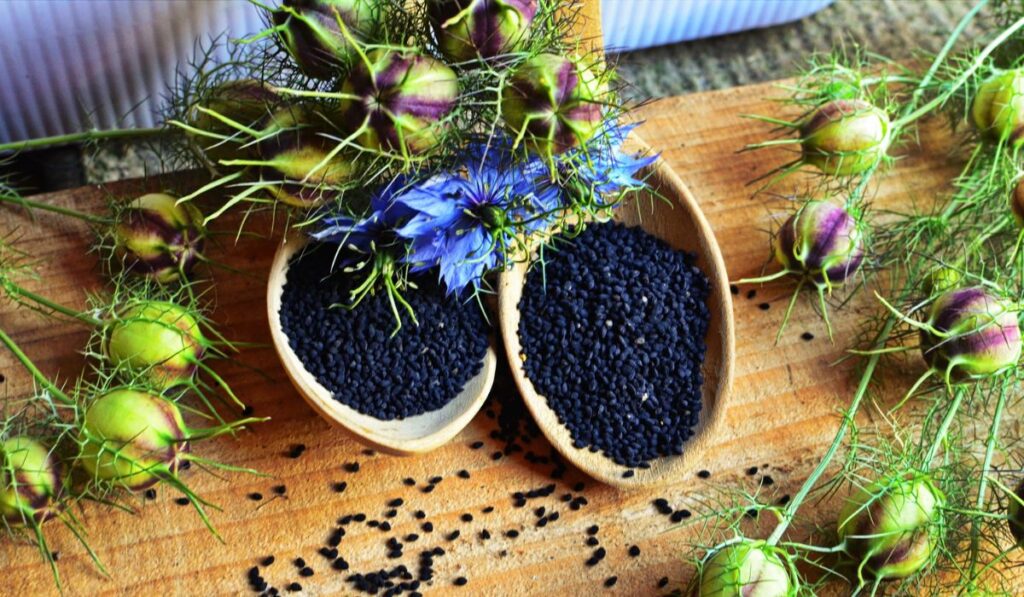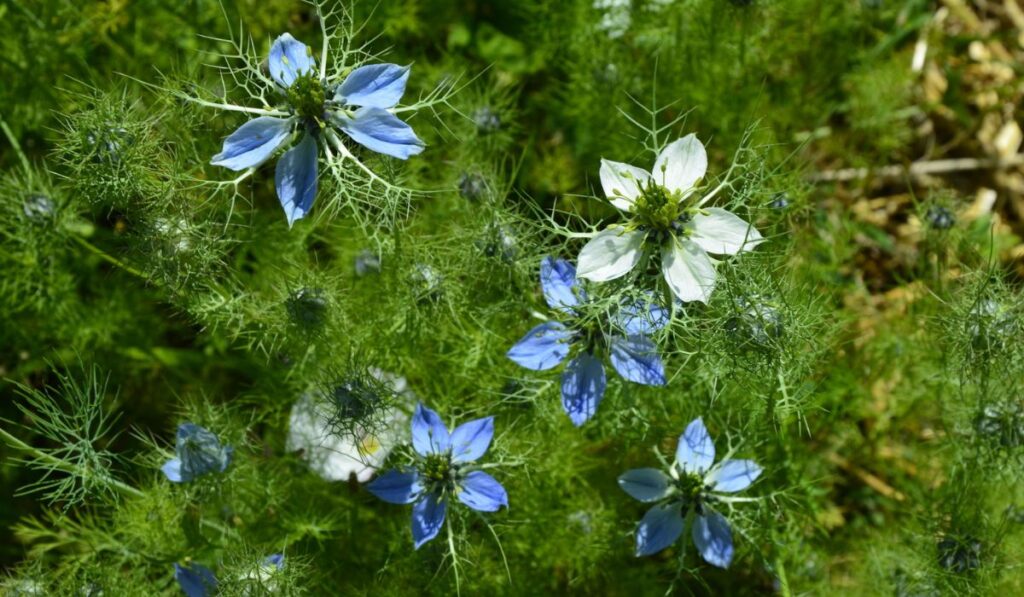Nigella is a charming annual plant that makes an excellent, long-lasting cut flower. It’s also easy to grow, and you can think of it as a “sow and forget” bloom because you can sow its seeds directly in the soil and expect them to sprout reliably.
You can plant Nigella seeds from late spring to early summer when the soil temperature is about 60°F (~15°C). Plant the seeds with general-purpose fertilizer where they’ll get full sunlight for a good bloom. The soil should also be consistently moist as the seeds germinate.
In the summer, you’ll see Nigella flowers on thin, upright stems with feathery green leaves and large, inflated seed pods resembling balloons. But if the plant struggles to bloom, ensure it’s got adequate water and fertilizer. You can also deadhead the flowers and thin the plants to encourage more blooming. Let’s explore everything in detail.
What is Nigella?

Nigella, commonly known as “love-in-a-mist” or “devil in the bush,” is an annual garden flowering plant that belongs to the buttercup family called Ranunculaceae.
Its scientific name is Nigella damascena, and the genus name Nigella comes from “niger,” the Latin name for black. It gets that from the plant’s intense, black seeds.
Nigella is one of about a dozen species in the buttercup family, and it’s common in Southern Europe and northern Africa. It grows in its native habitat in the fields, along roadsides, and on rocky grounds.
What to Expect
You can expect love-in-a-mist to grow 15 to 24 inches high and up to a foot wide if adequately spaced. The plant has finely cut, bright green leaves that look like fennel leaves. The “mist” bit of its informal name comes from the light green, lacy, finely divided bracts surrounding its jewel-like flowers.
The flowers usually range in shades from pale blue to bright blue, but you can also find some in white, pink, and lavender shades. Following the flowers are lovely, balloon-shaped capsules that can be up to 2” long. They’re usually green, with bronze or purple stripes.
Nigella in Gardens
Nigella looks attractive in the garden even after the flowers bloom due to its lovely foliage and seed pods after flowering. In addition, the airy foliage makes it blend well with other annuals, especially broader-leafed plants in your cottage garden.
Moreover, you can use it for short-term massed bedding and filling gaps in the flower border. You can add individual plants to window boxes, hanging baskets, and containers where the foliage gives a fair contrast before the plants bloom.
What are the Different Types of Nigella?
Several cultivars of the Nigella flower have been developed for gardens in many temperate areas. The seven common types of Nigella include:
- Miss Jekyll: A common and popular cultivar with flowers in white, blue, and rose shades.
- Miss Jekyll Alba: A double, white-flowered variety whose seed pods have a bright green shade.
- Nigella papillosa: An attractive variety whose fragile, single blooms have prominent black stamens. Its height can reach 19 inches, and its spread can be 12 inches.
- Blue Midget: A dwarf cultivar that grows to just about 10 inches (25 cm) tall, making it suitable for edging.
- Persian Jewels: A pretty variety with a mixture of purple, pink, blue, lavender, rose, and white shades. It can grow up to 18 inches tall.
- Cambridge Blue: A long-stemmed variety with double flowers; easy to cut.
- Nigella Midnight: A cool variety with prominent, velvety-blue flowers.
Other cultivars of love-in-a-mist you could look into include Albion, Oxford Blue, and Mulberry Rose.
When is the Best Time to Plant Nigella Seeds?
Since Nigella blooms for only a couple of weeks, it is best to plant its seeds during late spring or early summer.
You could sow the seeds two or three times from late spring to early summer, and the plant will easily reseed itself. Then, if you’re lucky enough, the seeds can overwinter in your garden and sprout to life in the spring.
Nigella is an annual that doesn’t like to be transplanted, and it’s best to directly sow the seeds outdoors so the roots won’t be disturbed as you transplant. Here are the tips for planting love-in-a-mist seeds:
- If you’re planting in early spring, sow the seeds when the soil temperature hits 60 ℉ ( 15.5 ℃).
- Disperse the seeds in a sunny location and carefully rake them in. You don’t want to cover them completely with soil, as they’ll need a lot of sunlight to germinate properly.
- Germination will occur in about two to three weeks, and you must keep the soil moist.
- Once the seedlings have burst to life, thin them carefully to ensure they’re spaced 8 to 10 inches apart.
How to Care for Nigella

While Nigella is a lovely cottage garden plant, it’s somehow short-lived and may not always make it through an entire growing season.
If you’re looking for continuous blooms throughout the summer, you might want to make succession plantings every three weeks. This goes until the plants have begun to scatter seeds themselves to save you the hassle of sowing.
Here’s how to take care of love-in-a-mist plants:
Soil
Nigella will grow and bloom best in fertile soils with enough nutrients and a neutral pH, regardless of physical qualities like texture. While it prefers moist sandy soil, it can tolerate various soil types, including loam, clay-loam, and gritty soils.
Water
Nigella does well in consistent moisture conditions—it just doesn’t like to sit in wet soil. So water it gently until you’ve saturated the top couple of inches of soil.
Temperature
Love-in-a-mist thrives in temperatures between 65 ℉ and 72 ℉, which is why you should sow in early spring when the soil has warmed up to 60 ℉.
Light
While Nigella will do fine in partial shade, you should plant it in full sun if you’re looking for the most blooms.
Fertilizer
Use general-purpose fertilizer when planting Nigella, then add more once a month afterward. Be careful to read the product label instructions to find out the correct amount to use.
